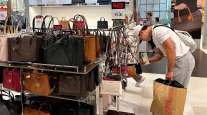Consumer Spending Gain Lags Behind Income for Second Month

Consumer spending lagged behind income growth for a second month in February, showing American households were taking a breather after a late-2017 surge. Inflation, meanwhile, ticked up.
Purchases, which account for about 70% of the economy, rose 0.2% after a similar advance at the start of the year, Commerce Department figures showed Thursday. Incomes grew 0.4% for a third month. The Federal Reserve’s preferred measure of inflation climbed 1.8% from February 2017, the most in nearly a year.
RELATED: Jobless claims decline to lowest level since January 1973
Adjusting for changes in prices, spending was little changed after a January decline, consistent with economists’ forecasts for a slower pace of real household demand this quarter following the strongest gain in three years. Consumers may be moderating their purchases after credit-card balances mounted in late 2017.
While the saving rate rose to 3.4%, the highest since August 2017, spending could gather pace in coming months due to a robust labor market, elevated confidence and lower taxes.
The Fed’s preferred inflation gauge — tied to consumption — rose 0.2% from the previous month. Excluding food and energy, so-called core prices also increased 0.2% and were up 1.6% from February 2017, the biggest gain since April 2017.
While inflation has mostly remained below the central bank’s 2% target since 2012, Fed officials have said they expect to keep making progress and continue raising rates gradually.
RELATED: Economic growth revised higher on spending, inventories
The tax-cut legislation signed in December, and one-time bonuses announced by several companies in its wake, are helping to supplement workers’ take-home pay. Still, wages have been rising only gradually during the expansion even as hiring has exceeded expectations. That’s one reason some people have taken on more debt.
Wages and salaries increased 0.5% in February after a 0.6% gain, the data showed. Disposable income, or earnings adjusted for taxes and inflation, advanced 0.2% after a 0.6% jump that was the largest since December 2012.
The report follows disappointing results for retail sales, which unexpectedly fell in February for a third month amid a decline in purchases at automobile dealers.
While Fed officials remain upbeat about the outlook for households, economists are penciling in some softening for the first quarter. The median forecast in a Bloomberg survey showed consumer spending slowing to a 2.1% rate in the January through March period.
That’s about half as much as the 4% annualized pace in the fourth quarter that helped boost gross domestic product to a 2.9% rate, a government report showed March 28.
Other Details
• Durable goods spending, adjusted for inflation, rose 0.6% after a 1.6% decline in the prior month; nondurable goods purchases fell 0.3% after a 0.4% drop
• Household outlays on services, adjusted for inflation, were little changed after a 0.1% gain
With assistance by Jordan Yadoo




